Authors: Daren Matsuoka (a16z Partner), Robert Hackett (a16z Features Editor), Eddy Lazzarin (a16z CTO), etc.; Translation: Jinse Finance xiaozou
The world is moving towards full blockchainization.
When we published our first crypto report, the space was still in its adolescence, the total crypto market capitalization was half of what it is today, and blockchains were slower, more expensive, and less stable.
Over the past three years, crypto builders have weathered market crashes and policy uncertainty, yet continued to drive major infrastructure upgrades and technological breakthroughs. These efforts have brought us to the present moment— a historic moment when crypto assets are becoming a vital part of the modern economy .
The crypto narrative for 2025 is about industry maturity . In short, the crypto world has grown up:
Traditional financial giants (Visa, BlackRock, Fidelity, JPMorgan Chase) and tech-native challengers (PayPal, Stripe, Robinhood) have launched crypto products;
The blockchain’s transaction volume exceeded 3,400 per second (more than a hundredfold increase in five years);
Stablecoins support $46 trillion in annual transaction volume ($9 trillion adjusted), comparable to Visa and PayPal;
The value of Bitcoin and Ethereum exchange-traded products has surpassed $175 billion.
This year's report delves into the industry's transformations, from institutional adoption and the rise of stablecoins to the convergence of crypto and AI. We also debut a crypto data dashboard to track the industry's evolution through key metrics.
The following are the key points of this article:
The crypto market has become large-scale, globalized, and continuously growing;
Financial institutions fully embrace crypto assets;
Stablecoins are entering the mainstream;
The resilience of the U.S. crypto ecosystem has reached a historical peak;
The global process of chain-based transformation is accelerating;
Blockchain infrastructure is approaching a critical point of maturity;
Deep integration of encryption and artificial intelligence technology.
1. The crypto market has become large-scale, globalized, and continuously growing.
In 2025, the total crypto market capitalization surpassed $4 trillion for the first time, demonstrating a significant leap forward for the industry. The number of mobile crypto wallet users surged 20% year-over-year, reaching a record high. The dramatic shift from regulatory resistance to policy support, coupled with the accelerated adoption of technologies like stablecoins and the tokenization of traditional financial assets, will define the trajectory of the next cycle of development.
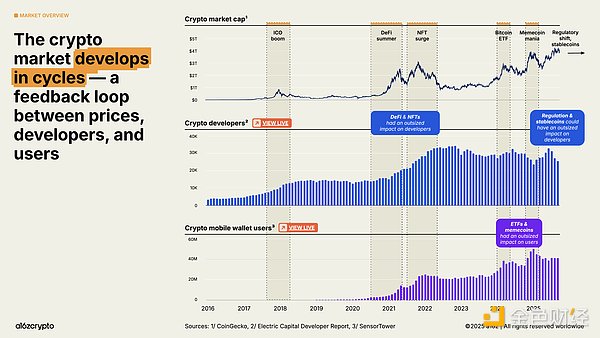
According to our analysis and estimates based on updated methodology, there are currently approximately 40 million to 70 million active crypto users worldwide, an increase of approximately 10 million from last year.
This figure only accounts for a small proportion of the world's 716 million crypto asset holders (a year-on-year increase of 16%), and is far lower than the number of monthly active addresses on the chain of approximately 181 million (a year-on-year decrease of 18%).
The gap between passive holders (who own crypto assets but do not conduct on-chain transactions) and active users (who regularly conduct on-chain transactions) reveals a significant opportunity for crypto builders: how to reach potential user groups that already hold crypto assets but have not yet participated in on-chain activities.
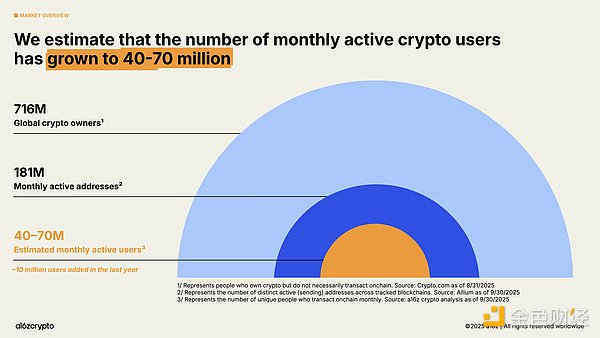
So where are these crypto users located and what are they doing?
While the crypto ecosystem is global in nature, different regions around the world exhibit distinct usage patterns. Mobile wallet usage, an indicator of on-chain activity, has grown fastest in emerging markets like Argentina, Colombia, India, and Nigeria (particularly in Argentina, where crypto mobile wallet usage surged 16-fold amidst the ongoing currency crisis over the past three years).
At the same time, our analysis of the geographic origins of token-related network traffic shows that token interest indicators are more skewed towards developed countries. Compared to user behavior in developing countries, activity in countries such as Australia and South Korea may be more concentrated in the trading and speculation sectors.
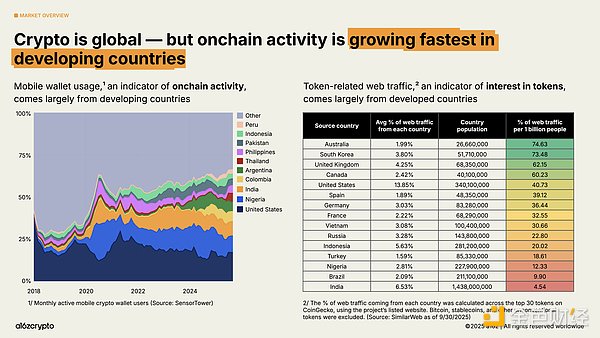
Bitcoin (which still accounts for over half of the total crypto market capitalization) has gained favor among investors as a store of value, reaching a new all-time high above $126,000, while Ethereum and Solana have recovered most of the losses from their 2022 crash.
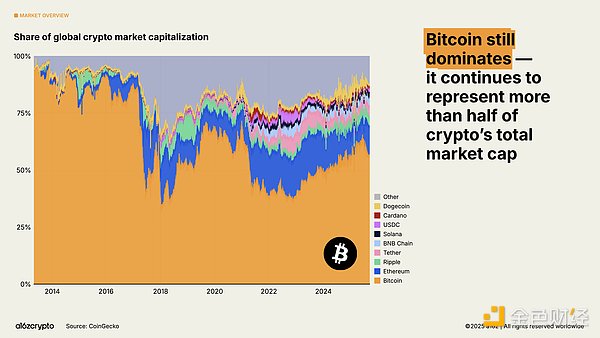
As blockchains continue to scale, fee markets mature, and new applications emerge, certain metrics are becoming increasingly important. One such metric is "real economic value"—a measure of the actual fees users pay to use a blockchain. Currently, Hyperliquid and Solana account for 53% of revenue-generating economic activity, a significant shift from the earlier dominance of Bitcoin and Ethereum.
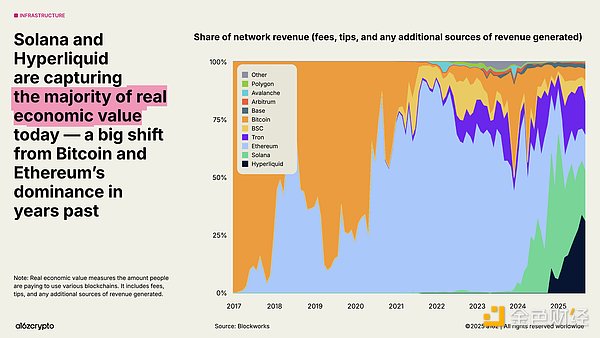
From a developer perspective, the crypto world remains multi-chain, with Bitcoin, Ethereum and its Layer 2 network, and Solana forming the three core developer hubs. In 2025, Ethereum and its Layer 2 network became the top targets for new developers, while Solana was one of the fastest-growing ecosystems, with developer interest increasing by 78% over the past two years. This data comes from a16z's crypto investment team's research and analysis of entrepreneurs' preferred development platforms.
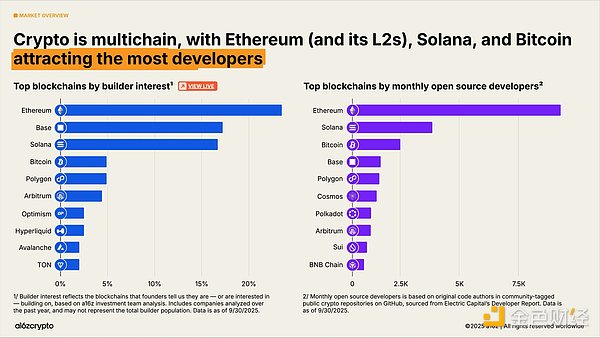
2. Financial institutions fully embrace crypto assets
2025 could be considered the year of institutional adoption. Just five days after last year’s “State of Crypto” report declared stablecoins to have achieved product-market fit, Stripe announced its acquisition of stablecoin infrastructure platform Bridge, marking the beginning of a public stablecoin investment by traditional financial firms.
A few months later, Circle's multi-billion dollar IPO marked the official entry of stablecoin issuers into the ranks of mainstream financial institutions. The bipartisan GENIUS Act, passed in July, provided clear guidance for developers and institutions. Since then, mentions of stablecoins in SEC filings have increased by 64%, and major financial institutions have seen a surge in announcements about their investments.
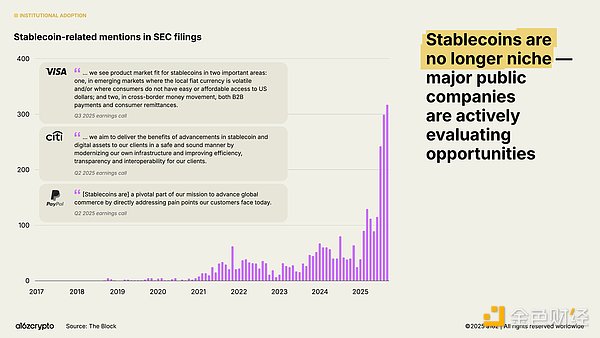
Institutional adoption is accelerating. Traditional financial institutions such as Citigroup, Fidelity, JPMorgan Chase, Mastercard, Morgan Stanley, and Visa have begun (or plan to) offer crypto products directly to consumers, enabling them to buy, sell, and hold digital assets alongside traditional instruments like stocks and exchange-traded products. Meanwhile, platforms like PayPal and Shopify are doubling down on their investments in the payments sector, building the infrastructure for everyday transactions between merchants and consumers.
Beyond offering direct products, major fintech companies like Circle, Robinhood, and Stripe are actively developing or have announced plans to develop new blockchains focused on payments, real-world assets, and stablecoins. These initiatives have the potential to drive more payment flows onto blockchains, foster enterprise adoption, and ultimately build a larger, faster, and more global financial system.
These companies have vast distribution networks, and if development continues, crypto technology has the potential to be fully integrated into the financial services we use every day.
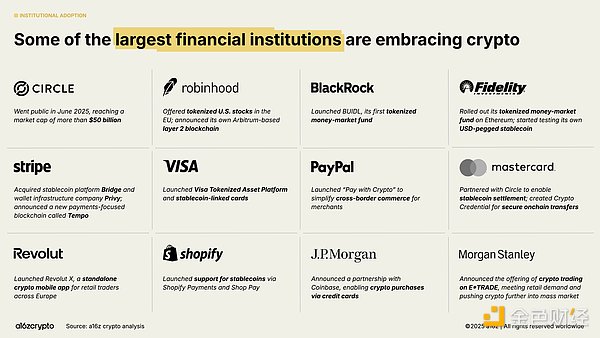
Exchange-traded products have become another key driver of institutional investment, with on-chain crypto asset holdings now exceeding $175 billion, a 169% surge from $65 billion a year ago.
BlackRock's iShares Bitcoin Trust has been hailed as the most actively traded Bitcoin exchange-traded product ever, and its subsequent Ethereum exchange-traded product has also seen significant inflows in recent months. (Note: Although often referred to as exchange-traded funds, these products actually file S-1 filings with the SEC to register as exchange-traded products, indicating that their underlying assets do not consist of securities.)
Such products significantly lower the investment threshold for crypto assets and open up an entry channel for large-scale institutional funds that have historically lingered on the periphery of the industry.
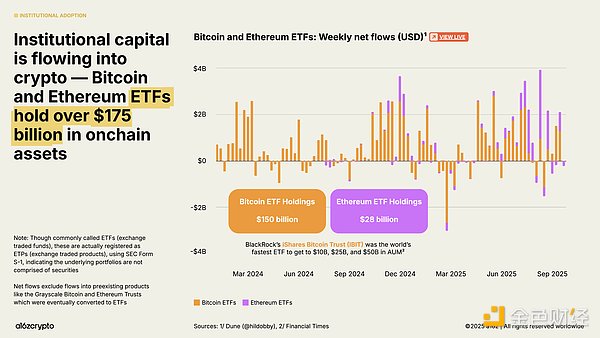
Publicly traded "digital asset reserve" companies—entities that hold crypto assets on their balance sheets (similar to how corporate treasuries hold cash)—currently hold approximately 4% of all circulating Bitcoin and Ethereum. Together, these digital asset reserve companies and exchange-traded products hold approximately 10% of the circulating supply of Bitcoin and Ethereum.
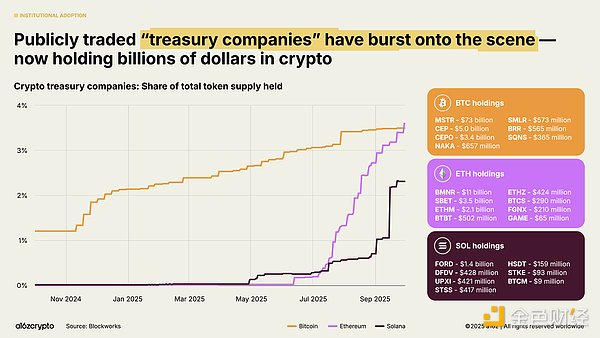
3. Stablecoins enter the mainstream
The most telling sign of the crypto market's maturity in 2025 is the rise of stablecoins. Previously used primarily to settle speculative crypto transactions, stablecoins have become the fastest and cheapest way to transfer US dollars globally in the past two years, processing millions of transactions per second at a cost of less than a cent per transaction, and reaching the vast majority of the world.
This year, stablecoins have become the mainstay of the on-chain economy.
Over the past year, total stablecoin transaction volume reached $46 trillion, a year-on-year increase of 106%. While this primarily represents fund movement (as distinct from retail payments through card schemes), it is already three times the size of Visa and approaching the ACH network, which runs through the entire US banking system.
After adjustment (excluding robots and artificial inflated data), the actual transaction volume of stablecoins in the past 12 months was US$9 trillion, an increase of 87% year-on-year, more than five times the volume processed by PayPal and more than half the size of Visa.
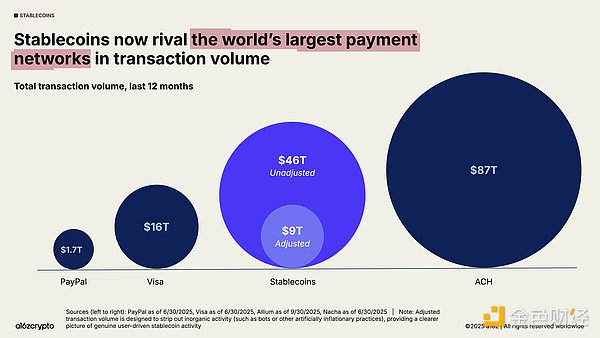
Adoption is accelerating. Adjusted monthly stablecoin transaction volume has soared to a record high, reaching nearly $1.25 trillion in September 2025 alone.
Notably, this activity has a low correlation with overall crypto trading volume – suggesting that stablecoins are being used for non-speculative purposes and, more importantly, confirming product-market fit.
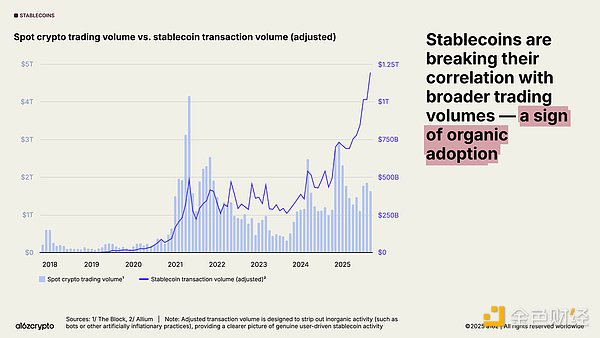
The total supply of stablecoins also hit a record high, now exceeding $300 billion.
The market is dominated by leading stablecoins: Tether and USDC account for 87% of the total supply. In September 2025, the Ethereum and Tron blockchains processed $772 billion in adjusted stablecoin transactions, representing 64% of all transactions. While these two issuers and blockchains account for the majority of stablecoin activity, emerging blockchains and issuers are also gaining momentum.
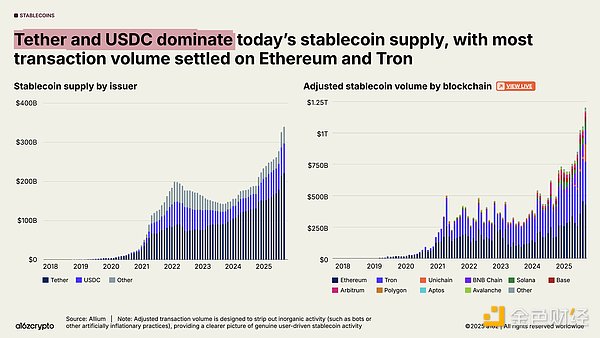
Stablecoins have become a significant force in the global macroeconomy: over 1% of the US dollar exists in tokenized stablecoins on public blockchains, and their ranking in US Treasury holdings has risen from 20th last year to 17th. Stablecoins now collectively hold over $150 billion in US Treasury bonds—more than many sovereign nations hold.
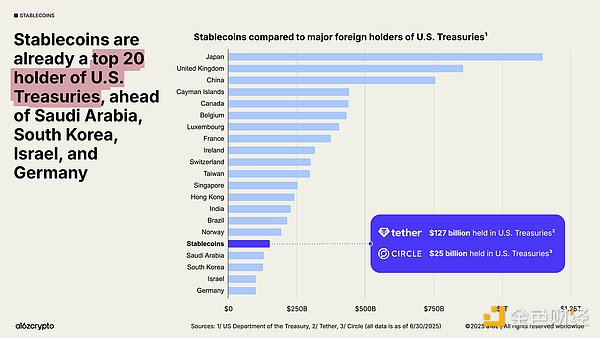
Meanwhile, the U.S. national debt has surged even as global demand for Treasuries has weakened. This is the first time in 30 years that foreign central banks have held more gold than U.S. Treasuries.
But stablecoins are bucking the trend: over 99% of them are denominated in U.S. dollars, and their size is expected to grow tenfold to over $3 trillion by 2030, which could provide a strong and sustainable source of demand for U.S. debt in the coming years.
Even as foreign central banks reduce their holdings of U.S. Treasuries, stablecoins are still consolidating the dollar’s dominance.
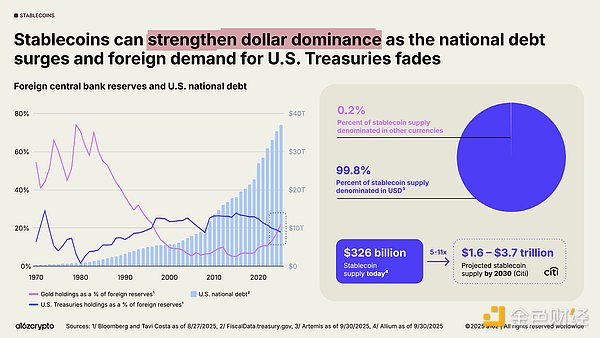
4. The resilience of the U.S. crypto ecosystem has reached a historical peak
The United States has reversed its previous opposition to the encryption field and restored the confidence of builders.
The passage of the GENIUS Act and the House approval of the CLARITY Act this year signal bipartisan consensus that crypto assets will not only survive in the United States, but are well-positioned to thrive. Together, these two bills establish a framework for stablecoin regulation, market structure, and digital asset oversight that balances innovation and investor protection. Simultaneously, Executive Order 14178 rescinded earlier anti-crypto directives and established an interagency working group to modernize federal digital asset policy.
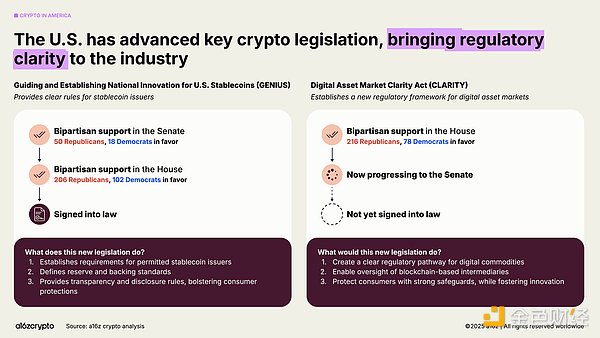
The regulatory landscape is paving the way for builders to fully unleash the potential of tokens as a new digital primitive—much as websites were to previous generations of the internet. As regulatory frameworks become clearer, more network tokens will close the economic loop by generating returns that accrue to holders, creating a self-sustaining new economic engine for the internet that allows more users to share in the system's dividends.
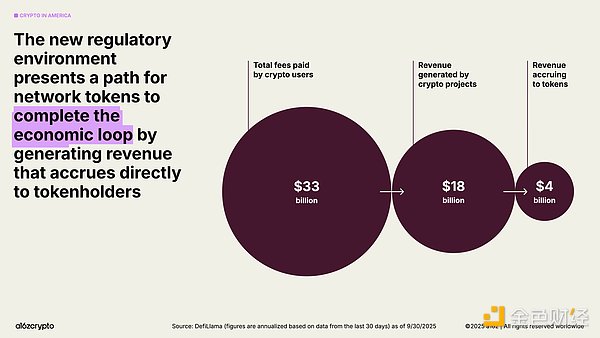
As a translation expert in the fields of encryption and blockchain, please translate the following English text into Chinese, keeping the formatting of the translated text consistent with the original text.
5. Global acceleration of the chain process
What was once a niche testing ground for early adopters has evolved into a diverse ecosystem with tens of millions of monthly active participants. Nearly one-fifth of spot trading volume now occurs on decentralized exchanges.
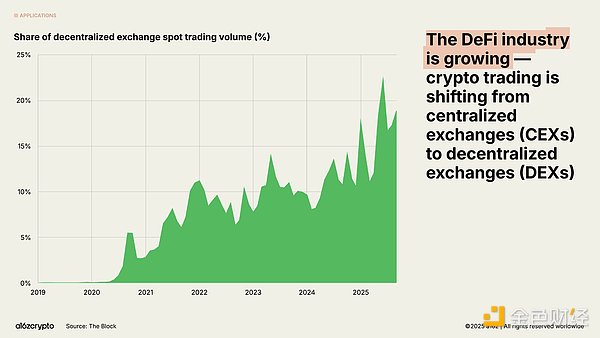
Perpetual swap trading volume has surged nearly eightfold over the past year, demonstrating explosive growth among crypto speculators. Decentralized perpetual swap exchanges like Hyperliquid have already processed trillions of dollars in trading volume and generated over $1 billion in annualized revenue this year—figures that rival those of some centralized exchanges.
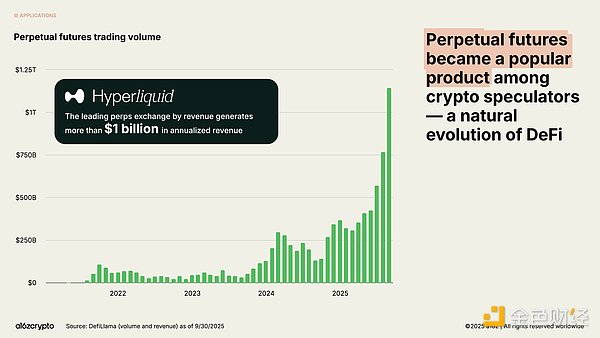
Real-world assets—including traditional assets like U.S. Treasuries, money market funds, private credit, and real estate—are being tokenized on-chain and are bridging the gap between crypto and traditional finance. The total market size for tokenized RWAs has reached $30 billion, having nearly quadrupled in the past two years.
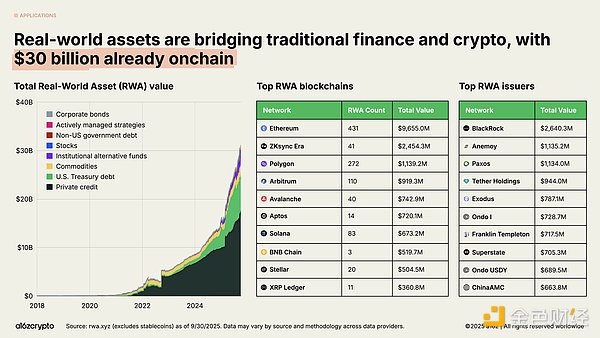
Beyond finance, the most ambitious frontier for blockchain in 2025 is DePIN – the decentralized physical infrastructure network.
Just as DeFi is reshaping the financial system, Decentralized PIN (DeFi) is reshaping physical infrastructure like telecommunications networks, transportation systems, and energy grids. This sector has enormous potential: the World Economic Forum predicts that the Decentralized PIN market will reach $3.5 trillion by 2028.
The Helium network is a prime example: this grassroots-driven wireless network currently provides 5G cellular coverage to 1.4 million daily active users through over 111,000 user-operated hotspots.
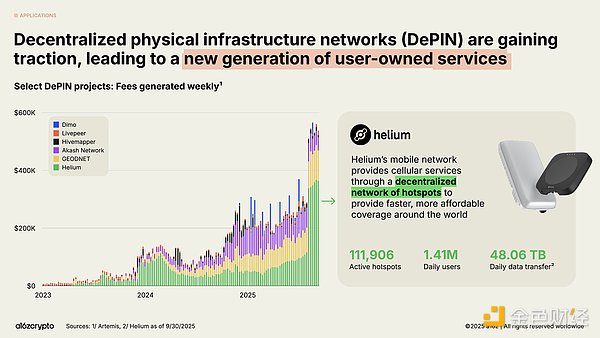
Prediction markets broke into mainstream popularity during the 2024 US presidential election cycle, with leading platforms Polymarket and Kalshi reaching billions of dollars in monthly trading volume. Despite initial concerns about their ability to maintain activity in a non-election year, these platforms have seen trading volumes increase nearly fivefold since the beginning of 2025, approaching historical peaks.
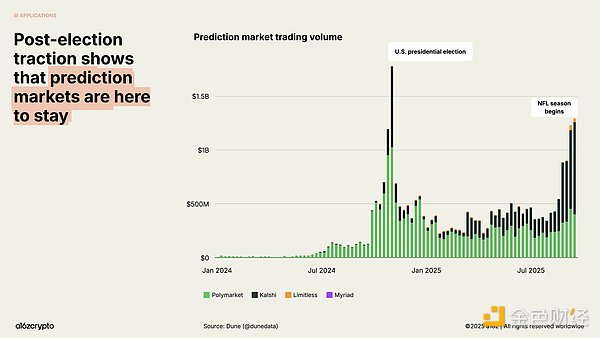
In the absence of clear regulation, Memecoin saw explosive growth, with over 13 million tokens launched in the past year. However, this trend has cooled in recent months, with issuance dropping 56% in September compared to January, as positive policies and bipartisan legislation have paved the way for more constructive blockchain use cases.
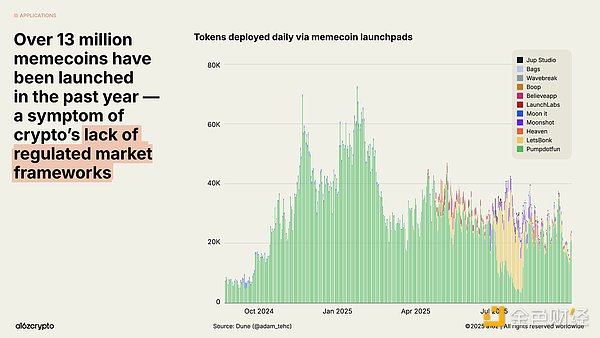
Although NFT market transaction volume has not returned to its 2022 peak, the number of monthly active buyers continues to grow. These trends seem to indicate that consumer behavior is shifting from speculation to collection, and the lower block space costs on chains such as Solana and Base provide the conditions for this.
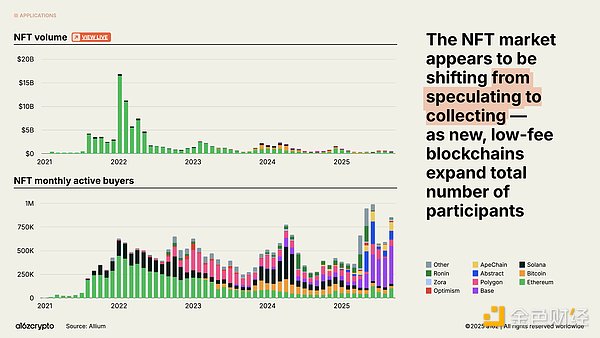
6. Blockchain infrastructure is approaching a critical point of maturity
None of this activity would be possible without significant advancements in blockchain infrastructure.
In just five years, the total transaction throughput of major blockchain networks has increased over 100-fold. Previously, blockchains processed fewer than 25 transactions per second, but now they handle 3,400 transactions per second, on par with Nasdaq's transaction speed and Stripe's global processing volume during Black Friday, all at a fraction of the historical cost.
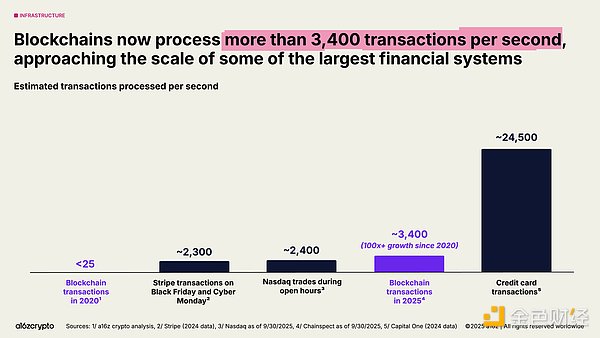
Solana has become one of the most prominent players in the blockchain ecosystem. Its high-performance, low-fee architecture now powers a wide range of applications, from DeFi projects to NFT marketplaces. Its native applications generated $3 billion in revenue over the past year. Planned upgrades are expected to double the network's capacity by the end of the year.
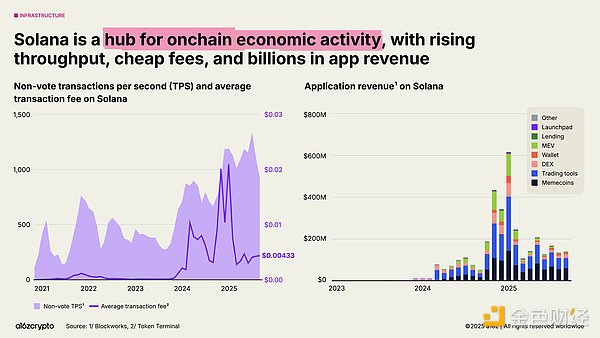
As Ethereum continues to advance its scaling roadmap, the majority of economic activity has migrated to second-layer solutions like Arbitrum, Base, and Optimism. The average L2 transaction cost has dropped from approximately $24 in 2021 to less than a cent today, making Ethereum-related block space both cheap and plentiful.
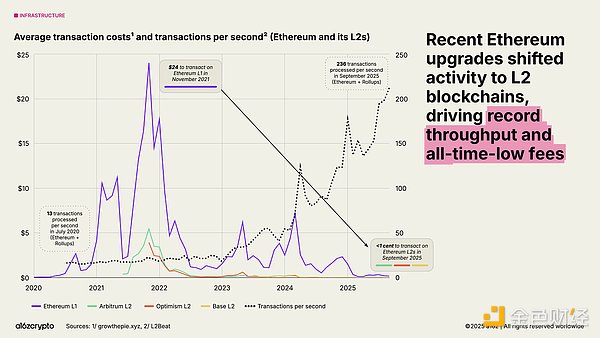
Cross-chain bridges are enabling blockchain interoperability. Solutions like LayerZero and Circle's Cross-Chain Transfer Protocol enable users to transfer assets across multiple blockchain systems. Hyperliquid's Regulated Bridge has generated $74 billion in transaction volume year-to-date.
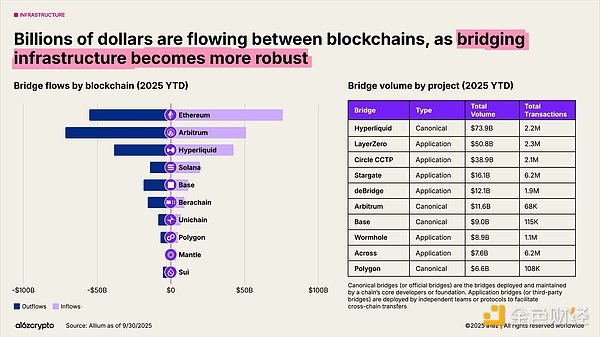
Privacy protection is returning to the forefront and may become a prerequisite for mass adoption. Signs of this increased interest include a surge in Google searches related to crypto privacy in 2025, the growth of Zcash's shielded pool supply to nearly 4 million ZEC, and Railgun's monthly transaction volume exceeding $200 million.
Further signs of momentum include the Ethereum Foundation establishing a new privacy team, Paxos partnering with Aleo to launch a private and compliant stablecoin (USAD), and the Office of Foreign Assets Control lifting sanctions on Tornado Cash, a decentralized privacy protocol. We expect this trend to gain momentum in the coming years as crypto continues to gain mainstream adoption.
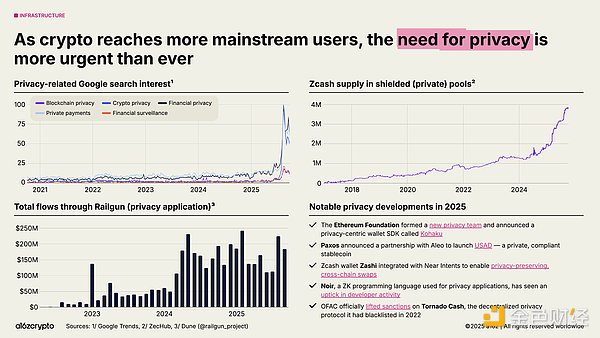
Similarly, zero-knowledge proofs and succinct proof systems are rapidly evolving from decades of academic research to critical infrastructure. Zero-knowledge systems are now integrated into Rollups, compliance tools, and even mainstream web services—as exemplified by Google's new ZK identity system.
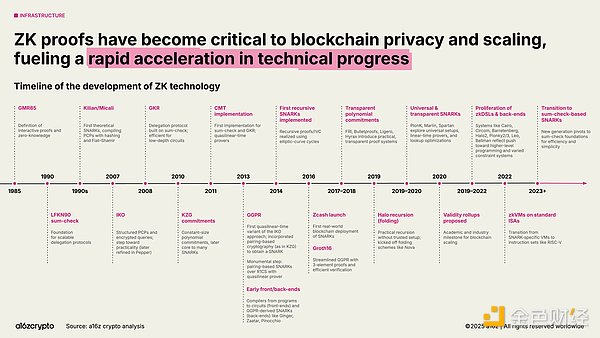
Meanwhile, blockchain is accelerating its quantum-resistant computing roadmap. Currently, approximately $750 billion worth of Bitcoin is stored in addresses vulnerable to future quantum attacks. The US government plans to transition federal systems to quantum-resistant cryptographic algorithms by 2035.
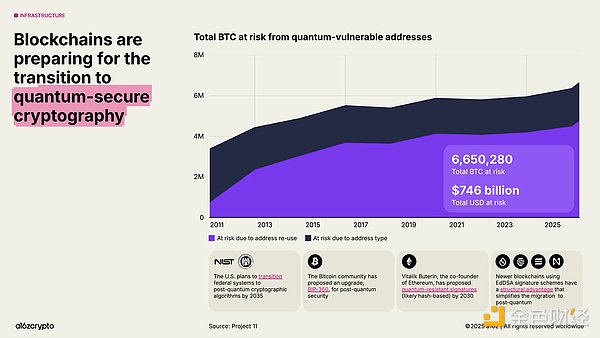
7. Deep integration of encryption and artificial intelligence technology
Among the many technological advancements, the launch of ChatGPT in 2022 has thrust AI into the public spotlight—a clear opportunity for the crypto space. From enabling traceability and IP licensing to providing payment channels for intelligent agents, cryptography could be the answer to AI’s most pressing challenges.
Decentralized identity systems such as Worldcoin, which has verified over 17 million users, can provide "proof of humanity" and help distinguish real users from robots.
Emerging protocol standards such as x402 are becoming the potential financial infrastructure for autonomous AI agents, helping them complete micropayments, API calls, and intermediary-free settlements - Gartner predicts that the scale of this economy could reach US$30 trillion by 2030.
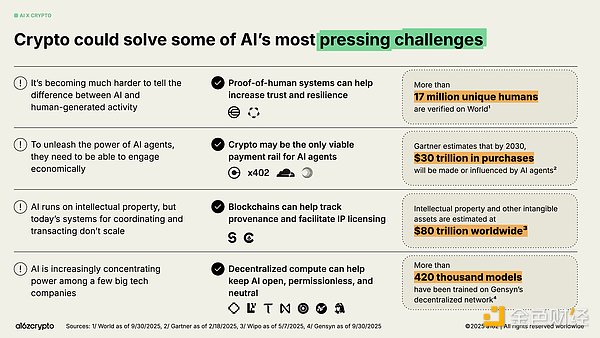
At the same time, the computing layer of AI is consolidating around a handful of tech giants, raising concerns about centralization and censorship. Currently, OpenAI and Anthropic alone control 88% of "AI-native" enterprise revenue. Amazon, Microsoft, and Google hold 63% of the cloud infrastructure market, while Nvidia holds 94% of the data center GPU market. This imbalance has enabled the "Big Seven" companies to achieve double-digit net profit growth for several consecutive quarters, while the earnings growth of the remaining 493 companies in the S&P 500 has generally failed to outpace inflation.
Blockchain technology provides a check and balance on the centralized power exhibited by AI systems.
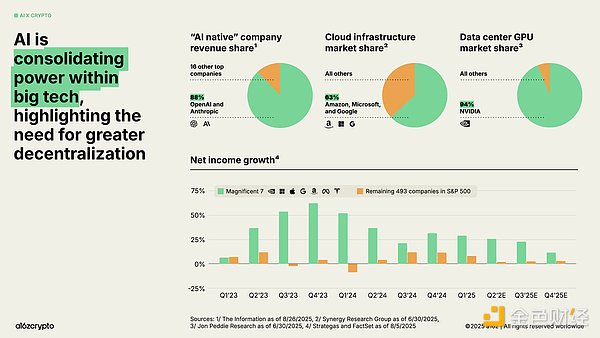
Amid the AI boom, some crypto builders have shifted to AI. Our analysis shows that approximately 1,000 jobs have moved from the crypto industry to the AI field since ChatGPT's release. However, this loss has been offset by an equal number of builders joining the crypto industry from other fields, such as traditional finance and technology.
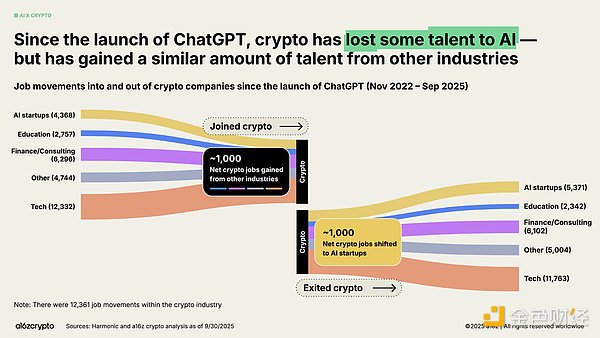
8. Future Outlook
Where are we now? As regulatory frameworks become increasingly clear, the path for tokens to generate real revenue through fees is becoming clearer. Crypto adoption by traditional finance and fintech will continue to accelerate; stablecoins will upgrade the traditional financial system and promote global financial inclusion; and new products will usher in the next wave of users into the on-chain world.
We already have the infrastructure and distribution networks, and we are poised to gain the regulatory certainty needed to mainstream the technology. Now is the time to upgrade our financial system, rebuild global payment channels, and build the internet we want.
After seventeen years of development, the crypto industry is bidding farewell to its adolescence and entering maturity.








